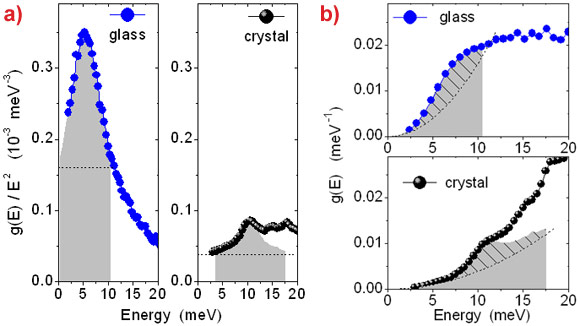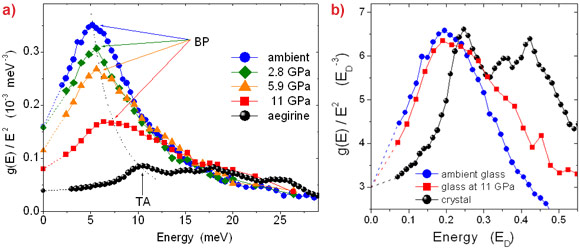- Home
- News
- General News
- Why chaos is warmer...
Why chaos is warmer than order
19-05-2011
Following many decades of theories and discussions, an international team of scientists working at the ESRF has finally obtained a decisive conclusion on the nature of the boson peak. Their results reveal the origin of the differences in thermodynamic and heat transport properties between glasses and crystals.
Share
Glasses are remarkably different from crystals at low temperature. They accumulate more heat and conduct less. This anomaly is related to a particular ensemble of atomic motions called the “boson peak”, whose nature has remained unknown for more than 50 years.
Before the 1960s, a glass was thought to be an ideal elastic medium, where atomic motions are determined by sound waves according to the Debye model. According to C. Kittel’s textbook, “the point was so obvious that it did not encourage experimental investigation”. This state of blissful ignorance ended when measurements of specific heat and thermal conductivity revealed tremendous deviations from the Debye behaviour. A little later these deviations were attributed to the boson peak – a universal feature in the density of vibrational states (DOS) for all glasses. Since then, the vibrations of atoms in glasses have remained a point of controversy. Dozens of theoretical models and hundreds of experimental results did not provide a unified picture of how disorder in atomic positions makes glasses thermodynamically so different from ordered crystals.
Because of the lengthy research period, the boson peak has been called the last puzzle of solid state physics. Driven by the distinction from crystalline properties, the majority of theoretical models explained the boson peak by embracing features beyond sound waves.
An international team of scientists combined efforts to find a definitive solution to this problem. Numerous staff at the ESRF were involved, and the experiments were carried out at beamlines ID18, ID27 and ID28. Their results have just been published in the scientific journal Physical Review Letters. Aleksandr Chumakov, leading author for the publication and scientist at beamline ID18,commented, “All decisive X-ray data were taken at the ESRF. But we also crucially relied upon German, American, Italian, and Polish Institutes with expertise in sample preparation, high pressure experiments, sound velocity measurements and ab initio calculations”.
Giulio Monaco, scientist at beamline ID16, said, "Glass dynamics is a traditional scientific topic at the ESRF. These particular studies were based on a tremendous previous experience gathered by both nuclear inelastic scattering and inelastic X-ray scattering experiments at beamlines ID18 and ID16".
The scientists at the ESRF compared atomic motions in a glass and a crystal using nuclear inelastic scattering, a technique that determines an exact number of vibrational states. Their results show that around the boson peak, the number of states in a glass is exactly the same as the number of sound wave states in the crystal. Thus, the glass has no additional modes in excess of the sound waves in the crystal.
Wilson Crichton, who undertook data collection at ID27, commented, "In addition to collecting information on the compressed glass, we crystallised it at 1400 K and 3.5 GPa. This way we obtained and identified the reference crystal chosen not occasionally but in a strict sense by our glass”.
The scientists also investigated the effect of pressure on the glass sample. Increasing the pressure caused a gradual transformation of the boson peak towards a particular (van Hove) singularity of the crystal created by sound waves with a period equal to the crystal periodicity. Measurements of density and sound velocity suggest that the transformation is caused by a gradual stiffening of the elastic medium. Once corrected for the difference in the elastic medium (re-plotted in the Debye energy units), the boson peak matches the transverse acoustic singularity in height and energy.
These observations unambiguously identify the boson peak with sound waves. They lead to the conclusion that the anomaly in the heat capacity of glasses comes not from the additional modes, but from conventional sound waves, which, however, have lower frequencies in glasses due to structural disorder.
Thus, more heat can be stored in a glass not because chaos allows for more vibrations, but because the disorder within the glass changes the sound waves. Unexpectedly, but in accordance with the general theory of knowledge, the sound-wave nature of glass anomalies revealed here is a return to the earliest of ideas, but with the addition of a new level of understanding.
Publication
Equivalence of the Boson Peak in Glasses to the Transverse Acoustic van Hove Singularity in Crystals, A.I. Chumakov, G. Monaco, A. Monaco, W.A. Crichton, A. Bosak, R. Rüffer, A. Meyer, F. Kargl, L. Comez, D. Fioretto, H. Giefers, S. Roitsch, G. Wortmann, M.H. Manghnani, A. Hushur, Q. Williams, J. Balogh, K. Parliński, P. Jochym, and P. Piekarz, PRL 106, 225501 (2011); DOI 10.1103/PhysRevLett.106.225501.
Top image: The sodium silicate glass sample and the diamond anvil cell (inset) used in the nuclear inelastic scattering experiments.





